
Portasol Pro Piezo PP-1K soldering iron
Review date: 15 March 2000.Last modified 03-Dec-2011.
"The three most dangerous things in the world are a programmer with a soldering iron, a hardware type with a program patch and a user with an idea."
Want to get into the first category?
A cordless iron's what you need.
That way you can strike without warning, any time, anywhere.
Soldering irons aren't just handy for meddling with things you don't understand, of course. They can also be used to extract information from enemy agents. And when you get tired of that, there are lots of useful little jobs you can do with them. Want to splice in a new case fan that doesn't come with a power connector? Want to put a connector in the middle of a plugpack lead so you can use a battery pack instead of the wall wart? Want to build that battery pack yourself, out of cells as humungous as you like, without paying outrageous prices? You can't do it without a soldering iron, folks.
And butane soldering irons are darn handy things. You can use 'em anywhere, any time, without having to plug into the wall. They don't have a cord (or a heavy battery pack) so they're easier to use for fine work. They get decent run time from one filling of butane gas (usually from 20 minutes to an hour, depending on model and heat setting), refilling them takes only about 20 seconds, and the gas is dirt cheap.
And they're flexible, too; most of them let you swap in not only different sized soldering iron tips, but hot blow tips for heat-shrink work, hot knives for cutting plastic, and flame tips for brazing. Pretty much universally, they have an adjustment dial on the bottom that you use to set the temperature, and an on/off valve on the side that's pushed to the off position if you put the cap back on the iron.
The caps are made of high-temperature plastic so they don't mind being replaced while the iron's still at full temperature; you can jam the cap on and throw the iron straight back in your toolbox. Shoving it into your back pocket is less advisable.
Pretty much all butane irons don't use an open flame, unless you've selected the flame tip. They have little catalytic combustion screens built into their other tips, which glow merrily and don't let any flame out. There's certainly enough heat coming out to set fire to, say, a piece of paper that you put over the iron, but they're not much of a hazard. Considering their convenience, they're marvellous.
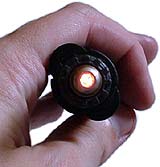
Looking into the Pro Piezo's hot blow tip. Lots of glow, but no flame.
Probably the best gas irons in the world are made by Oglesby & Butler, in Ireland. Their Portasol/Weller branded range has been around for years; scads of field service types use their Portasol Technic and Portasol Professional irons, because they're pretty cheap, tough, and replacement tips are widely available. The ubiquitous orange Technic sells for $AU50 or so here in Australia, from various decent electronics stores. It's got a 10 to 60 watt power rating - enough for quite heavy duty work. The black Portasol Pro costs $AU40 or so more, but comes with hot blow, hot knife and torch tips, and has the same power rating.
These irons are old hat, though. You actually have to light them with a flint sparker, built into the cap. Primitive, m'dear, primitive.
Piezo-electric ignition's what you want. Click a switch, light the iron.
And Portasol can provide!
Click-to-ignite!
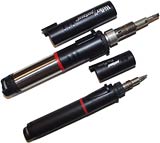
SuperPro (top) versus Pro Piezo (bottom).
The SuperPro's even chunkier than it looks.
My everyday iron for a while now has been a Portasol SuperPro (sold as the PS-100K here in Australia), a silver-barreled piezo ignition behemoth with a 125 watt power rating, which sells here for about $AU150. With a fat chisel tip, you can use this monster for plumbing soldering; turned down low, it's OK for fine-ish work.
But if the new PP-1K Pro Piezo (also known as the "PP-1K") had been available here when I bought the SuperPro, I would have gone for it instead. You do not need a SuperPro for just about any electronics soldering job, and the heft and alarming maximum power of the big iron are in fact a handicap when you're trying to do fiddly work.
An overpowered iron can lift tracks from circuit boards, toast components, or just overheat the work so that the solder takes too long to solidify. Many pro soldering stations are seldom set to power levels much above 25W, if they even support them; it might make you feel butch to have an iron capable of melting a car battery terminal, but that doesn't mean the thing's useful.
The Pro Piezo has, for all but the most heavy duty jobs, all of the good features of the SuperPro and none of the problems. It's as small and elegant as the cheap spark ignition irons, but it's got piezo ignition, a good set of standard tips, and a capacious gas reservoir (about 45 minutes of use, at medium settings). Its rated power is 15 to 75 watts, which is ample.
Using it

It's probably not good that
the magic expanding sponge
excites me so much.
Setting up the Pro Piezo is dead easy. Fill it, stick the stand into the case, wet the magic expanding tip-cleaning sponge, and you're ready to rock and roll.
The Pro Piezo comes with one mid-sized chisel point soldering tip, a hot blow tip (with clip-on deflector for heatshrinking), a flame tip and a hot knife. Like the SuperPro, the Pro Piezo has a slightly clumsy ring-and-sleeve retainer system to hold its tips on. I think this design was picked because it lets the iron use a nice big outside-threaded connector on its end, rather than the small inside-threaded hole of other irons, which would seem to complicate the combustion chamber design, not to mention wear out faster.

Hot blow tip with deflector in place.
It's always tricky to swap tips on a butane iron when it's hot - you have to use pliers. Then again, electric irons don't even have hot blow or blowtorch tips, and usually retain their tips with a fiddly little screw; they're certainly no better.
Once you get the hang of it, swapping tips on a Pro Piezo or SuperPro (or Pro II, the slightly less extreme version of the SuperPro) is easy enough. And that's pretty much the hardest thing about using the iron. But there are some other quirks.
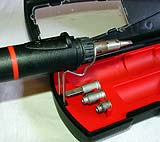
The wire stand isn't marvellous, but it's convenient.
In operation, a butane iron is the same as an ordinary electric one, except there's no cord to worry about, and there's a very hot breeze coming out of the side of the tip. If you put the iron down with the breeze blowing on your table, you'll scorch the table. This is easy enough to avoid, and there's a perfectly good little wire stand that plugs into the side of the Pro Piezo's case, but I still occasionally forget the iron's orientation and singe a finger. It builds character.
Filling the iron's simple enough, too. Attach appropriate nozzle to standard, cheap, butane can; invert; squirt into valve on base of iron. All you have to do is avoid overfilling the iron. If you put too much gas in, your iron will misbehave in ways amusing to you and alarming to spectators until it blows off the excess.
This is because pressure regulation is a bit of a problem for all butane irons - and dedicated torches, for that matter. They have a tendency to get a bit overenthusiastic when they're completely full. For a couple of minutes after filling a butane iron, even if you don't think you've overfilled it, you should stick to the lower power settings. At the higher ones, a well-filled iron will occasionally burp out a little liquid butane and blow itself out.
The torch attachment is the one to use for amusement after filling the iron; now, the little bubbles will cause the iron to flame out with a momentary yellow plume as it extinguishes itself, and the valve makes entertaining quacks and whistles as it deals with the overpressure. This is not really dangerous at all - the flame-outs occur for only a fraction of a second before the torch blows itself out, and aren't likely to hurt anything. Bigger butane torches often stay lit when flaming out, which can be very exciting indeed if you're not ready for the effect.
When using the flameless tips, the over-filled self-extinguishment problem is just a minor irritation, which can be neutralised by using lower power settings until the gas level's dropped a bit. Even if the iron blows itself out when you're not looking and pumps out unburned butane, it's not much of a risk; butane is heavier than air and will sink to the floor and, in most rooms, leak out of the room harmlessly without getting close to an explosive or even ignitable mixture. If you're in a well-sealed basement, on the other hand, keeping a more than usually vigilant eye on your iron can be wise.
When the iron isn't completely full, it never goes out of its own accord.
The only real limitation of butane irons is that they don't give you precise temperature control. For many jobs, this doesn't matter at all - you know you need middle power, or full power, or low power, and that's all - but for fine electronic work it's nice to be able to set an exact temperature and get really consistent results. If that's your thing, then a proper electric temperature controlled soldering station is what you need. But you're not going to be able to use that too easily if you're up in the scaffolding fixing the control board for a motorised stage light, now are you?
Torch it!
Most butane irons have a blowtorch mode - sometimes you just unscrew whatever tip you're using and light the bare gas outlet, sometimes there's a special screw-on torch attachment.
The PP-1K's blowtorch attachment is far and away the best I've seen, because it's very hard to blow out.
Every other butane torch, single purpose or soldering-capable, seems to do most of its combustion outside the nozzle. This makes it very easy for even quite light breezes to "blow the flame away" and extinguish the torch.
The PP-1K has a bright blue flame inside the nozzle of its stubby torch attachment, and a slender needle-flame outside. On the minimum power setting, the torch mode becomes practically just an overenthusiastic hot-blow gun, with practically no combustion outside the nozzle; on full power, it just looks like an oddly thin and dim torch flame which is close to impossible to extinguish without turning the thing off. The end of the iron heats up almost as fast in torch mode as it does in soldering mode; as the nozzle starts to glow, the flame turns a cheerful red colour.
Every other blowtorch mode I've tried, including the PS-100K's, can't hold a candle to a $AU50 single-purpose butane torch. The PP-1K can. And its super-thin flame seems no cooler than any other butane torch, so you should be able to use it for precision silver soldering, brazing small pipes and so on. It doesn't have the flame area for bigger jobs, which are often beyond the $AU50 torches, as well. But, as the nice chap at Oglesby & Butler who sent me the Pro Piezo pointed out, it does a dandy job as a pipe-lighter, provided you don't get too enthusiastic and cremate everything in the bowl.
From my personal experience with nearby pipe smokers, I think that wouldn't necessarily be a bad thing. But I digress.
Overall
This is a really nifty gadget, not to mention useful. Having one tool that can easily handle fine or heavy electronic soldering, can elegantly shrink heatshrink tubing onto the joints afterwards, and can be used anywhere, is really handy. If you think it might be useful to learn to solder, rest assured that basic soldering is quite easy; just get an iron, a roll of ordinary resin-cored solder and a bunch of bits of wire to practice on and you can figure it all out in an afternoon.
I'll keep my SuperPro for those occasional four-gauge wires, but for pretty much every other job on computer or car, the Pro Piezo's a gem.
Recommended.
Portasol Pro Piezo kindly provided by
Oglesby & Butler.
Portasol products are distributed in Australia by
CooperTools.
(Well, they were when I first wrote this review, anyway. Jaycar has
a good range of them now.)
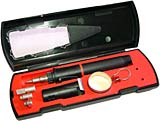

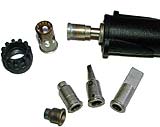


![[SecureWebs]](images/sw.gif)